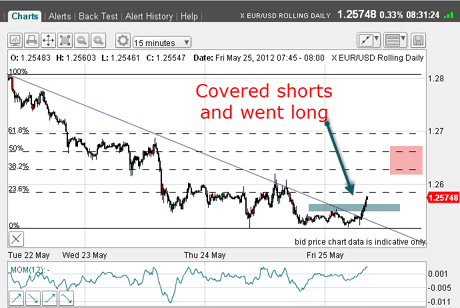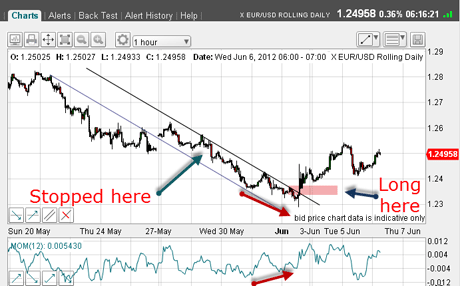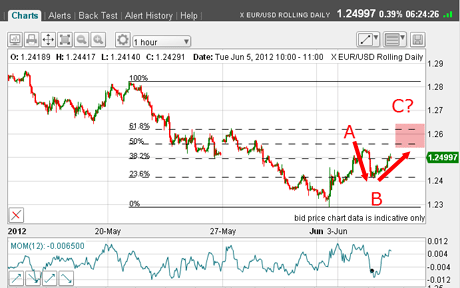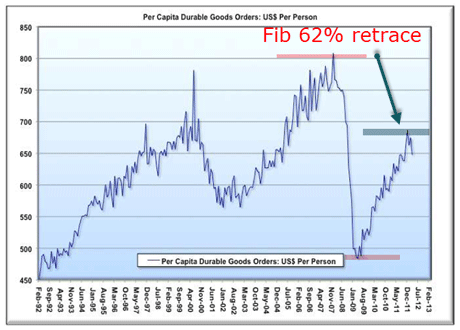Is the euro finally finding support now?
Just when it seems it can't get any worse for the euro - is often when you should expect a rally, says John C Burford. Has that time arrived?
During the long break for the Queen's Jubilee celebrations, the markets have been working away and the anticipated support I have mentioned in previous posts seems to be at hand.
In my post on 25 May, I had taken a substantial profit on the short side and had expected a decent rally. I had several reasons for suspecting a rally, which I laid out, andbelow is the chart I showed then.
To get to my promised land at the area of the pink bar, the market had to negotiate the considerable overhead resistance.
MoneyWeek
Subscribe to MoneyWeek today and get your first six magazine issues absolutely FREE

Sign up to Money Morning
Don't miss the latest investment and personal finances news, market analysis, plus money-saving tips with our free twice-daily newsletter
Don't miss the latest investment and personal finances news, market analysis, plus money-saving tips with our free twice-daily newsletter
Naturally, I had my protective stop in place just under the recent low in case the market decided it wanted to ignore my plans.

(Click on the chart for a larger version)
And sure enough, selling pressure was just too great and I was stopped out for a small loss.
Trader tip: Remember, as a trader, I have two rules:
1. To make as much profit on my profitable trades as possible
2. To lose as little capital as possible on my losing trades
Many very successful traders have more losing trades than winning ones. You may be surprised by this, but they are successful because the average size of their winners is greater than the average size of their losers. They are net profitable.
Was I just too early?
OK, I had a losing trade, but my bullish analysis was still correct, I believed. I decided to keep looking for a long entry. Recently, I noted with raised eyebrows that bullish sentiment had dropped into single figures and a relief rally was surely ahead.
And on Friday with the release of the US employment report, the market sank into new low ground but on a solid positive momentum divergence on the hourly chart. This is what I was waiting for.
And with a short-term tramline about to be broken on the upside, I was waiting with buy orders placed just above the tramline:

(Click on the chart for a larger version)
So my first attempt at finding a bottom was a failure, but now I have a promising long trade. I was early!
Trader tip: I am the type of trader that tends to be correct quite often, but early. You may be of a different type. And from experience, I know that I cannot change, and so I must keep losses small on any losing early trades before I latch onto a winner. But I must persevere, provided I still like my stance.
Many traders do not understand themselves enough to be able to trade within their character and that is why many fail at trading.
As I never tire of saying, every trader does battle with him or herself, not the markets.
To win, you must understand yourself. Trading the financial markets exposes our strengths and faults like no other activity I know.
So where are we this morning? Here is my Fibonacci overlay, which will guide me on this rally.
I have a potential A-B-C pattern in the making, and I have a pink bar at where ideally I would like to see the C wave end.

(Click on the chart for a larger version)
But with bullish sentiment on the floor, an exit for Greece openly discussed, and now Spanish banks needing huge bail-outs, can it get any worse for the battered euro?
Remember, markets make turns at extremes of sentiment. Could this be a case where all the bad news is already in the price? Even a glimmer of good' news could send shorts scrambling to cover to lock in their gains.
Also, who are the crazy people who are long? Don't they know the euro project is doomed? Well, according to the Commitments of Traders(COT) data, it is the large institutional traders the banks especially. These tend to be the strong hands in other words, the traders who are price-insensitive. They are often hedging to a time table, often to genuine commercial trade.
Just because GDP is down, the economy hasn't stopped! Commercial activity is still at a high level. Reading all the gloom and doom articles gives the opposite impression, doesn't it?
So doesn't it make sense to join the strong hands? Maybe they know something we don't!
Finally, to repeat Joe Granville's maxim: "when everyone agrees something is obvious, it is obviously wrong".
Fibonacci and the slowing US economy
Before I go, here is a fascinating chart that lies at the heart of the US economy a plot of the per capita durable goods orders since 1992.
On Monday, the Factory Orders report drew a lot of attention as it showed a surprise' marked slowing.
It roughly follows the chart of the Dow and peaked with the stock market in 2007, fell heavily during the credit crunch, as the public scaled back their purchases. It bottomed in March 2009 along with the Dow, and then rallied during the Great Reflation but the rally carried only to the Fibonacci 62% level, while the Dow sailed on to a much larger retrace.
So Fibonacci turns up in unusual places!

(Source: US Commerce Department)
(Click on the chart for a larger version)
If you're a new reader, or need a reminder about some of the methods I refer to in my trades, then do have a look at my introductory videos:
The essentials of tramline trading
An introduction to Elliott wave theory
Advanced trading with Elliott waves
Don't miss my next trading insight. To receive all my spread betting blog posts by email, as soon as I've written them, just sign up here .
Get the latest financial news, insights and expert analysis from our award-winning MoneyWeek team, to help you understand what really matters when it comes to your finances.
John is is a British-born lapsed PhD physicist, who previously worked for Nasa on the Mars exploration team. He is a former commodity trading advisor with the US Commodities Futures Trading Commission, and worked in a boutique futures house in California in the 1980s.
He was a partner in one of the first futures newsletter advisory services, based in Washington DC, specialising in pork bellies and currencies. John is primarily a chart-reading trader, having cut his trading teeth in the days before PCs.
As well as his work in the financial world, he has launched, run and sold several 'real' businesses producing 'real' products.
-
 UK sets out crypto regulatory proposals
UK sets out crypto regulatory proposalsThe government has tabled legislation that sets out a regulatory framework for cryptocurrencies, while the regulator will consult on balancing innovation and consumer protections
-
 What does an interest rate cut mean for my pension?
What does an interest rate cut mean for my pension?Interest rates have been cut from 4% to 3.75%. For pension savers and retirees the effects of the drop will depend on the type of retirement pot they have, but could be significant.